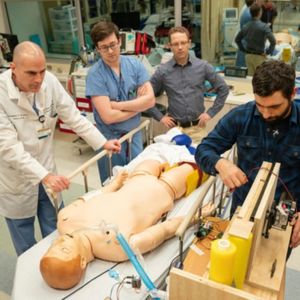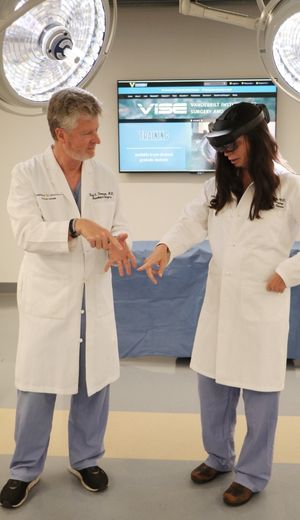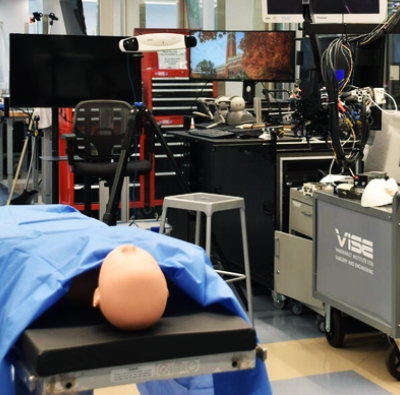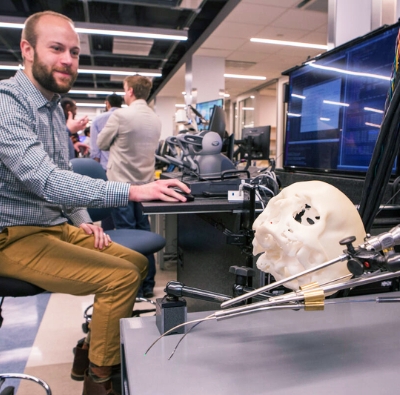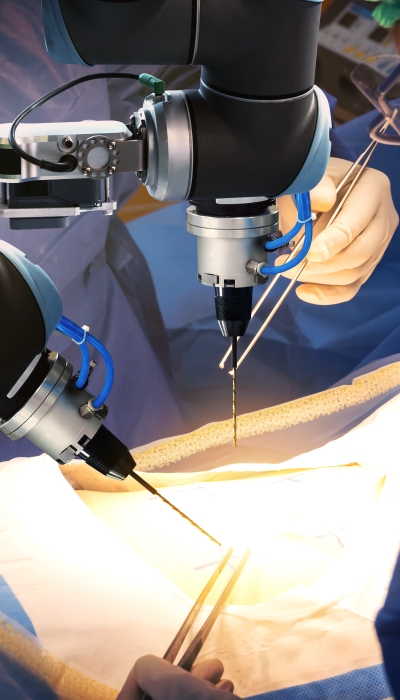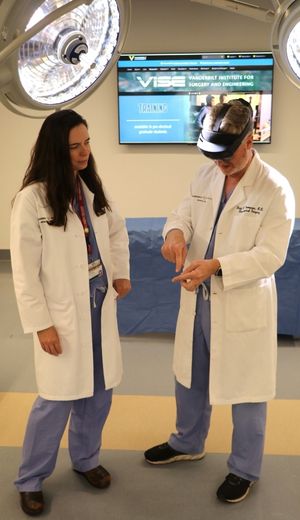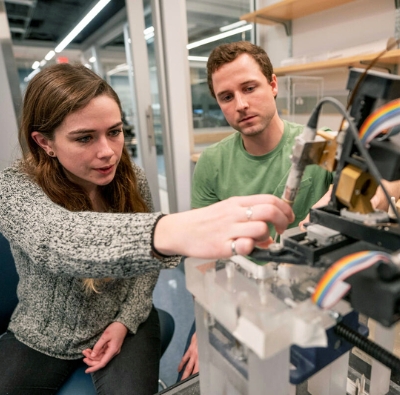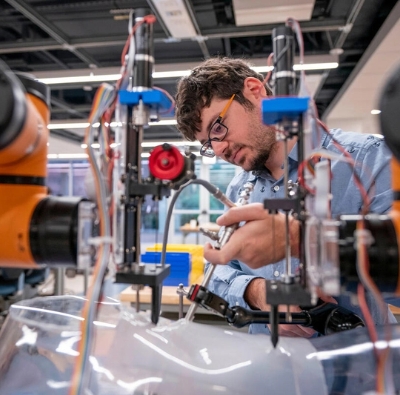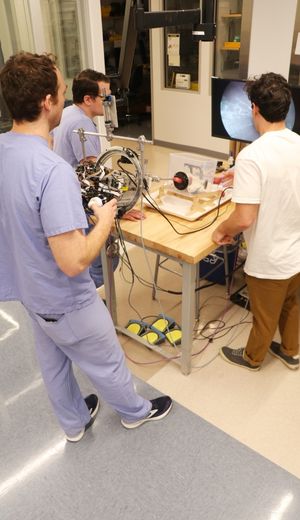The Future of Healthcare Technology:
Robotic Interventions, Technology-Guided Therapy, and Surgical Data Science
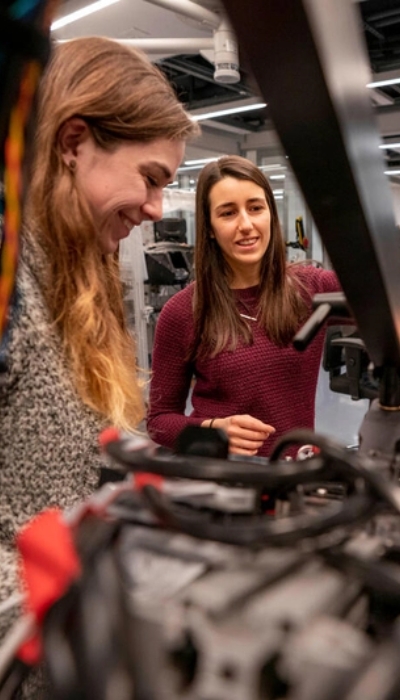
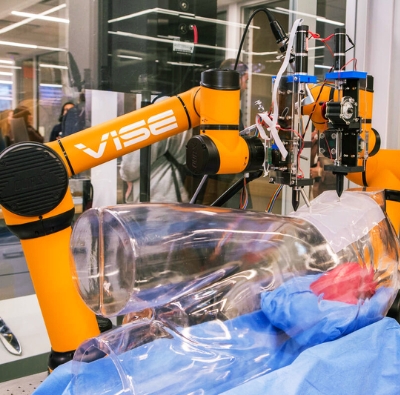
Over the past several decades, dramatic breakthroughs in biomedical science have been witnessed within laboratory research, but the ability to translate those findings and make new discoveries has been a challenge and has been often characterized as the ‘bottleneck’ of clinical translation.
At Vanderbilt University, we believe that the fundamental challenges and constraints associated with clinical translation will be dramatically improved with the training of engineers intimately familiar with medical procedures in order to produce novel technology-driven solutions.
In response, Vanderbilt School of Engineering, in partnership with the Vanderbilt Institute for Surgery and Engineering (VISE), offers a master of engineering in surgery and intervention — a focused, rigorous engineering graduate program that will prepare the next generation of engineers to address challenges and envision solutions at the interface of engineering and medicine.
You have the valuable opportunity to obtain a master’s degree in engineering at Vanderbilt School of Engineering that will place you at the forefront of innovative discovery — start exploring today.
Table of Contents
Table of Contents:
Request More Information
We have moved away from studying human disease in humans … We need to refocus and adapt new methodologies for use in humans to understand disease biology in humans.
— Elias Zerhouni, former Director of the National Institutes of Health
(source: NIH Record, vol. 65, no. 13).
Engineers and surgeons may not outwardly seem to be the most natural of partners — engineers work to innovate and develop new frameworks and systems, while surgeons perform intricate procedures on the human body. But together, these two disciplines produce lifesaving advancements.
Healthcare professionals today, and specifically surgeons, are experiencing the benefits of technological advancements that are developed by surgical engineering professionals who have harnessed the power of automation and data to augment healthcare procedures and services.
Automation in healthcare is a complex, multifaceted advancement — one that involves the novel use of instrumentation and the integration of data to guide, promote efficiency, and accuracy in procedural medicine. Groundbreaking automated technology in the context of surgical engineering reimagines healthcare processes and paves the way for additional cutting-edge advancements to save more lives.
Automation vs. Augmentation
It is critical to emphasize the difference between automation and augmentation. While the two concepts are related, there are significant, foundational differences that must be recognized.
Automation
Completely replaces human decision-making and actions with technology.
Augmentation
Supports and improves human decision-making and actions with technology
In surgical engineering, the goal is not to replace human surgeons, but to better assist and empower surgeons to provide phenomenal patient care — care with increased accuracy and precision, care that is guided by data specific to a patient’s disease, and care that comes with reduced risk in the operating room.
Autonomy levels and the role of humans in robot surgeries
Role of main stakeholders:
Active Oversight
Active Performance
Levels of Autonomy
Surgeon
Support Staff
Robot
Full Autonomy
A surgical robot is capable of actively performing surgical procedures autonomously, while the surgeon maintains active oversight.
Surgeon
Support Staff
Robot
Active Oversight
Active Performance
Active Oversight
Active Performance
Active Oversight
Active Performance
High Autonomy
A surgical robot strategizes and selects the strategy, while the qualified surgeon mostly oversees the surgical procedures.
Surgeon
Support Staff
Robot
Active Oversight
Active Performance
Active Oversight
Active Performance
Active Oversight
Active Performance
Conditional Autonomy
A surgical robot is capable of strategizing and executing the strategy approved by the surgeon autonomously under supervision.
Surgeon
Support Staff
Robot
Active Oversight
Active Performance
Active Oversight
Active Performance
Active Oversight
Active Performance
Task Autonomy
A surgical robot carries out specifically designated tasks initiated by the surgeon autonomously under the surgeon.
Surgeon
Support Staff
Robot
Active Oversight
Active Performance
Active Oversight
Active Performance
Active Oversight
Active Performance
Robot Autonomy
Robotic assistants are configured to constrain and correct the surgeon’s actions, while the surgeon controls at all times.
Surgeon
Support Staff
Robot
Active Oversight
Active Performance
Active Oversight
Active Performance
Active Oversight
Active Performance
No Autonomy
Simple mechanical equipment or devices with no autonomy and that are operated manually.
Surgeon
Support Staff
Robot
Active Oversight
Active Performance
Active Oversight
Active Performance
Active Oversight
Active Performance
Source: The Role of Humans in Surgery Automation
As a result of automation, healthcare professionals will continue to experience an evolving procedural environment with ever increasing safety, speed, and precision through the controlled delivery that automation affords. Augmentation will improve surgeons’s abilities through technologies designed to add powers of detection, discernment, and enhanced performance. These devices — rooted in data science and innovated by surgical engineers — include such technologies as robotic-assisted surgical procedures, algorithms for faster data retrieval, integration of imaging biomarkers to guide therapies, and automated processes that reduce equipment breakdown, to name several.
The future of surgery relies on the driven and data-driven professionals who are developing valuable augmentation technology needed to transform the way patients experience clinical care — will you join the cadre of surgical engineers the healthcare field needs?
The advent of innovative and impactful augmentation technologies in surgical engineering is something to recognize and celebrate. In recent years, more and more examples of augmentation advancements have been utilized by surgeons in the operating room and beyond.
Since the first robot-assisted surgical procedures took place in the mid 1980s, the use of augmentation in surgery has expanded exponentially. According to the device manufacturers’ data, there were approximately 644,000 robotic-assisted surgical procedures performed in the United States in the year 2017.
The increased use of augmented medical services throughout the years is evident: “the use of robotic surgery for all general surgery procedures increased from 1.8 percent to 15.1 percent from 2012 to 2018,” and these statistics have only continued to grow with the developments of new surgical engineering advancements.
Examples of augmentation in surgical engineering:
Robotics
Smart instruments
Imaging
Image processing
Data retrieval
Computer vision
Therapeutics
Artificial intelligence
Modeling and simulation
System integration
Traditional labor market information (LMI) shows a clear and growing demand for biomedical engineers in general, with jobs projected to grow by over 8 percent nationally and over 12 percent in the southeast over the next ten years.
There is particularly strong demand for biomedical engineering expertise in industries related to surgical and interventional technologies, where upwards of 20 percent of all biomedical engineers are employed.
The demand for engineers who have training in the area of surgery and intervention is high — and it only continues to increase.
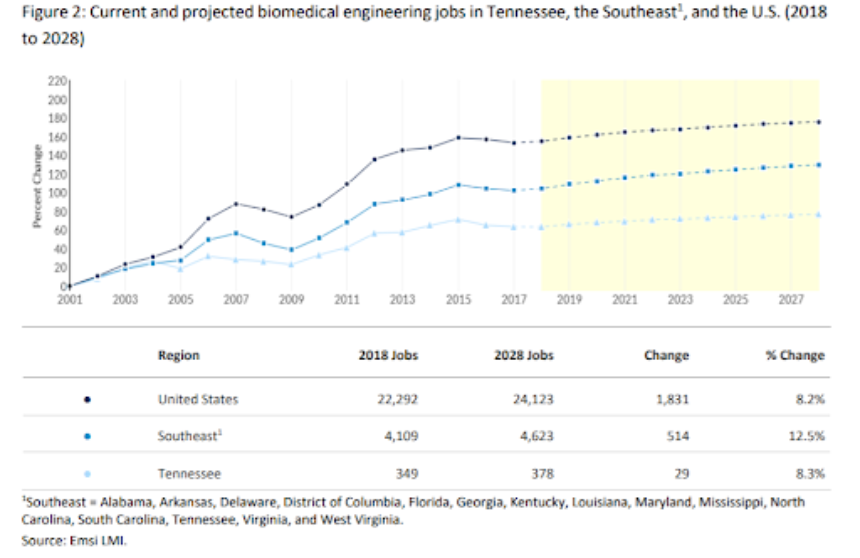
Overall, there is an approximately 60 percent gap between degree completion and job openings for biomedical engineers in general, both regionally and nationally. It is unclear to what extent this general deficit reflects the intervention and surgery engineering niche specifically, but a paucity of true competitors in the area and annual job postings on the order of thousands, not hundreds, suggests that there is a substantial gap between demand and supply in this specialization.
Types of Engineering Careers in Surgical Engineering
Engineering experts working in the field of interventional surgery are well equipped to secure varied types of engineering careers in surgical engineering, such as:
Surgical Engineer
Interventional Engineering
Medical Robotic Engineer
Robotic Engineer
Image Processing Engineer
Data Scientist
Modeling or Simulation Engineer
Medical Device Designer
Engineer Scientist
Medical Instrumentation Engineer
Medical Device Entrepreneur
Medical Materials Engineer
Drug Delivery Engineer Imaging Engineer
Imaging Scientist
Translational Engineer
Project Engineer
Staff Engineer
Surgical and interventional processes, devices and systems are complex. The conception, development, realization and evaluation of novel solutions require a close interaction between several engineering disciplines and clinicians. This necessitates environments in which engineering teams and practitioners can interact and exchange ideas on a daily basis.
The field needs engineering experts who can bring technology from the bench to the bedside.
Vanderbilt University’s goal is to recreate a unique environment in which barriers between technical teams and clinical teams are eliminated — where a constant exchange of ideas is possible, where solutions to problems can be proposed and where a performance dialog is continuous until clinically acceptable solutions can be realized.
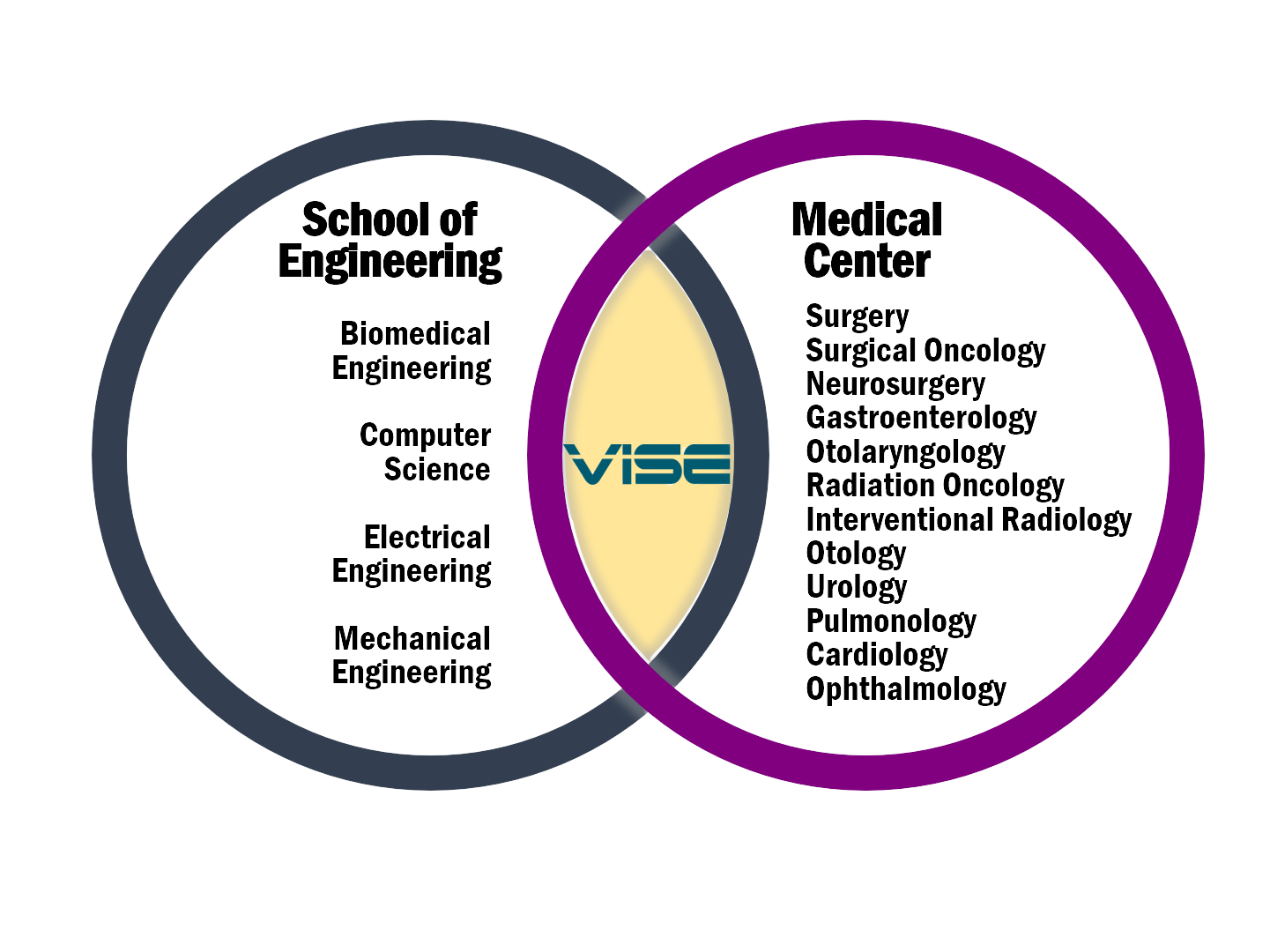
The master of engineering in surgery and intervention is designed to create a new cadre of engineers capable of creating, developing, clinically evaluating and translating methods, devices, algorithms and systems designed with a clear focus to facilitate surgical/interventional processes and their outcomes.
The master of engineering in surgery and intervention concentrates on the collaborative efforts of engineers and surgical experts to envision and implement technology and tools that transform the delivery of surgical/interventional care and ultimately, enhance and improve patients’ well-being and quality of life.
Examples of Vanderbilt engineering expertise and clinical applications include:
Engineering expertise:
Modeling and simulation
Robotics, devices and instrumentation
Imaging
Image processing and analysis
Data science
System integration
Interventional and surgical therapeutics
Clinical applications:
Image-guided brain, kidney, liver, pancreas or prostate surgery
Ultrasound monitoring of chemoembolization therapy
Novel modalities in neuromodulation
Nonlinear and steerable robotic probes for incisionless surgery
Robotic-assisted resection and implant surgeries Ophthalmic microsurgery
Students who pursue this degree commonly hold a bachelor’s degree in a conventional engineering discipline (e.g., mechanical, electrical, or biomedical engineering) or computer science. However, the program is also adaptable to other STEM areas as well (e.g., neuroscience, physics, mathematics, etc.). If you have questions, be sure to send inquiries to vuse.esi@vanderbilt.edu.
With regards to program structure, the master of engineering in surgery and intervention has two tracks: the innovator track and the inventor track. Each track is 30 credit hours and consists of core course work and electives — learn more about these two tracks below:
Innovator Track
The innovator track program is a one-year+ program specifically structured to enable students who are constrained by career path developments such that extended multi-year study is not possible. The goals of the program are to quickly provide enhanced skill sets with rigorous study, as well as provide important exposure to many clinical domains.
Typical curriculum for the innovator track of the Engineering in Surgery and Intervention (ESI) Program:
Fall Semester
ESI: Methods
Professional Development* (e.g. ENGM 6500)
Elective
Elective
Spring Semester
BME 6301 ESI: Provocative Questions
Elective
Elective
Elective
Summer I
ESI: Design I
Summer II
ESI: Design II
Inventor Track
The inventor track program is the same 30 credit hour program but is a more conventional option consisting of two-years of coursework. This track is specifically structured to enable students who have recently graduated with a bachelor’s degree and who wish to spend a concentrated period of time gaining skill sets within the engineering and surgery/intervention domain. This extended structure allows students to spend additional time within the novel research/design VISE environment to assist in the inception phase of their platform technologies in surgery and intervention.
Typical curriculum for the inventor track of the Engineering in Surgery and Intervention (ESI) Program:
Fall Semester – Year 1
ESI: Methods
Professional Development* (e.g. ENGM 6500)
Elective
Spring Semester – Year 1
BME 6301 ESI: Provocative Questions
Elective
Elective
Fall Semester – Year 2
Elective
ESI: Design I
Spring Semester – Year 2
Elective
ESI: Design II
*Note: There are several professional courses in the School of Engineering that would satisfy this requirement. This is done in consultation with the student’s adviser and program director. This can be satisfied in Fall or Spring.
M.Eng. in Surgery and Intervention
Course Descriptions
Within the master of engineering in surgery and intervention, there are five required core courses: one immersion, one methods, one professional, and two design. The remainder of the degree involves an additional five electives +Substitution of core components may be possible in consultation with the Program Director.
ESI - Immersion:
- BME 6301 — Engineering in Surgery and Intervention: Provocative Questions
- This course is designed to provide an in-depth clinical immersion with a scaffold design involving ten or more physicians from a variety of medical specialties discussing disease and dysfunction background, and the most common and challenging procedures, interventions and treatments in their practice. In addition, the clinical cadre proposes provocative questions for added discussion to encourage creativity and lateral thinking. Accompanying didactic lectures relate basic engineering principles to associated procedural medicine topics.
ESI - Methods+:(examples of satisfying courses are below, not a complete list)
- Devices: CS 8395 — Internet of Medical Things
- The course covers foundational topics for designing Internet of medical things (IoMT) solutions including systems (devices, interoperability, and integration), algorithms (data design, feature engineering, and time series machines learning), and commercialization (regulatory pathways and entrepreneurship). Case studies motivate challenges, solutions, and future opportunities in IoMT system and algorithm design to de-risk commercialization from concept to market adoption. Upon completion, students will be prepared to engage in commercially-viable IoMT research and development.
- Guidance & Delivery: EECE 8395 — Engineering for Surgery and Intervention
- Students will gain expertise in a breadth of technical topics of interest in engineering in surgery and other medical interventions, with focus on both theory and project experience. Topics will include interactive data visualization and analysis, image acquisition and reconstruction, registration and optical tracking, image processing, machine learning and deep learning, and bio modeling.
- Image Analysis & Data Science: CS 5262 — Foundations of Machine Learning
- Theoretical and algorithmic foundations of supervised learning, unsupervised learning, and reinforcement learning. Linear and nonlinear regression, kernel methods, support vector machines, neural networks and deep learning methods, instance-based methods, ensemble classifiers, clustering and dimensionality reduction, value and policy iteration. Explainable AI, ethics, and data privacy.
- Image Processing: CS 8395 — Open Source Programming for Medical Image Processing
- This hands-on course introduces students to the open-source libraries, tools and techniques for solving medical image analysis problems in research, commercial and clinical settings. The topics will include open-source libraries for addressing visualization needs that arise in medical image analysis, as well as open-source cross-platform software as development based for advanced work. This course will also use best practices, such as version management, needed for generating reproducible results.
- Imaging: BME 7420 — Magnetic Resonance Imaging Methods
- MR techniques to image tissue for clinical evaluation and research. RF pulses, k-space trajectories, chemical shift, motion, flow, and relaxation. Derivation of signal equations for pulse sequence design and analysis. Course includes hands-on experimental studies.
- Modeling: BME 7310 — Advanced Computational Modeling and Analysis In Biomedical Engineering
- By the end of this course, the student will understand the details of how to model different biological systems and some of the most current topics in modeling today. Additionally, a sound understanding will be developed between the mathematics of models and their physiological counterparts for future work in biomedical simulation, imaging, and therapeutic/surgical guidance. The student should gain a firm grasp of numerical methods for the solution of partial differential equations at the course conclusion.
- Robotics: ME 5271 — Robotics
- History and application of robots. Robotic mechanical architecture, mobility analysis of linkages, rotations and rigid body transformations and their parametrizations. Homogeneous coordinates of points and lines, exponential coordinates of rotation and twist coordinates, direct and inverse position analysis of serial manipulators and elimination theory. Serial robot statics and compliance, motion interpolation/path planning, instantaneous kinematics and Jacobian formulations. Lagrangian dynamics of serial robots, and motion control.
Professional Core:
- ENGM 6500+ — Engineering Leadership and Program Management
- Students will learn to apply core principles of leadership and program management as engineering professionals. The course will cover strategic planning, people management, staffing, compensation, business process improvement theory, business interruption, leadership styles, emotional intelligence, negotiation and ethical business practices.
Design Core:
- Six credit hours of BME/ME/ or EECE 7899 are required
- Students in this course are immersed in an intensive design project working with both clinical and engineering mentors that is focused at cutting edge solutions to contemporary surgical and interventional problems using their enhanced skills in engineering design acquired over the course of their training program.
Electives:
- The remaining 15 credit hours will be chosen from a number of electives. While not a complete list, some possible elective courses available are:
- All courses that qualify for ESI: Technical Methods
- BME 5400 Foundations of Medical Imaging
- BME 7110 Laser-Tissue Interaction and Therapeutic Use of Lasers
- BME 7310 Advanced Computational Modeling and Analysis in Biomedical Engineering
- BME 8901 Special Topics: Advanced Ultrasound Imaging
- BME 8901 Special Topics: Advanced Drug Delivery
- BME 8901 Special Topics: Polarized Light: Principles and Applications
- EECE 6357 Advanced Image Processing
- EECE 6354 Intelligent Systems and Robotics
- CS 5249 Projects in Virtual Reality
- CS 5262 Foundations of Machine Learning
- CS 8395 Special Topics - Deep Learning in Medical Image Computing
- ME 5263 Computational Fluid Dynamics and Multiphysics Modeling
- ME 5271 Robotics
- ME 5284 Modeling and Simulation of Dynamic Systems
- ME 8331 Robotic Manipulators
- ME 8391 Special Topics in Robotics and Mechanism Synthesis
While undergraduate degrees in engineering are a great foundation, within the domains of surgery and intervention, the need for specialized advanced training environments that combine clinical immersion and cutting-edge technology development has never been more pressing.
Vanderbilt has been the vanguard of this area of study. The master of engineering in surgery and intervention will uniquely position graduates to accelerate the translation of surgical and interventional therapies.
— Michael I. Miga, Ph.D., Director of the Biomedical Modeling Laboratory, Co-founder of the Vanderbilt Institute for Surgery and Engineering
Vanderbilt University’s strong history of and commitment to interdisciplinary work and the close proximity of its Medical and Engineering Schools makes it the ideal institution for advancing the state of the art technology in this field.
In conjunction with VISE, the School of Engineering provides a transformative infrastructure that facilitates this interdisciplinary work and creates an environment in which traditional boundaries are eliminated. In fact, Vanderbilt University is one of the only universities to offer such a ground-breaking program.
This type of program is highly needed within the industry, and Vanderbilt University is uniquely qualified to offer it.
The current members of VISE and those in emeritus status have been performing trans-institutional work for almost four decades now within the domains of surgery, intervention and engineering. This relationship is unique to Vanderbilt and has been maintained by the passion of the members devoted to this domain.
Over these four decades, this cadre has had the singular vision to see Vanderbilt as world leaders in this unique field. The VISE faculty firmly believe that what we have accomplished thus far is only a fraction of what is possible provided that institutional support and future investment are equally passionate.
In short, the focus of VISE and this master of engineering in surgery and intervention is exactly on this type of technology platform development for both treatment and discovery.
What sets Vanderbilt
School of Engineering apart:
Decades of investment in engineering, surgery and intervention research with world-class faculty
An unparalleled integration of engineering (VUSE/VISE) and clinical (VUMC) resources
Close proximity to VISE research center (colocated with medical center) allows engineering and surgical assets to collaborate
An intensive and supportive immersion experience with our clinical surgical professionals (~20 clinical specialties)
Extensive experience in commercial realizations among cadre
Opportunity for up-skilling or re-skilling via online or in-person workforce development programs
Vanderbilt University’s master of engineering in surgery and intervention is designed to create a new cadre of engineers capable of creating, developing, clinically evaluating and translating methods, devices, algorithms and systems designed with a clear focus to facilitate surgical/interventional processes and their outcomes.
By obtaining a master of engineering in surgery and intervention at Vanderbilt University School of Engineering, you will have obtained a graduate engineering degree that will place you at the forefront of surgical technological progress in a critical, impactful and growing field.
